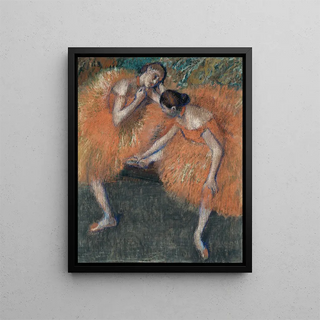Art print | Two Dancers - Edgar Degas


View from behind

Frame (optional)
In the fascinating world of art, some works transcend time and space, captivating the minds of enthusiasts and connoisseurs alike. "Two dancers" by Edgar Degas is a perfect example. This iconic piece, illustrating the passion and grace of ballet, immerses us in a fleeting moment of beauty and movement. The scene depicts two ballerinas, frozen in a delicate posture, revealing not only their technique but also the intensity of their artistic engagement. The light and shadow in this artwork, as well as the expression of the figures, invite us to explore a world where dance becomes a form of art in its own right, celebrating femininity and elegance.
Style and uniqueness of the work
Edgar Degas's style is characterized by a unique approach to depicting movement. In "Two dancers," he employs daring angles and asymmetrical compositions that bring his subjects to life. The ballerinas, although frozen on the canvas, seem to vibrate with energy, as if they are about to leap into action at any moment. Degas excels in the use of color and light, creating a striking contrast between the soft hues of the costumes and the shadows surrounding them. This art print also stands out for its pastel technique, which allows for a fluidity and delicacy rarely achieved in other mediums. The artist captures not only the physical beauty of the dancers but also the very essence of their art, making each brushstroke meaningful and evocative.
The artist and his influence
Edgar Degas, a major figure of the Impressionist movement, established himself through his ability to observe and capture everyday life with a unique sensitivity. Although influenced by his contemporaries, his distinctive approach to the subject, particularly through the lens of dance, enabled him to forge a style that is entirely his own. His works, including "Two dancers," demonstrate a deep understanding of human anatomy and an admiration for ballet, which was for him a true symbol of beauty and discipline. Degas's influence extends far beyond his era, inspiring generations of artists to explore movement, light, and representation.

Matte finish

View from behind

Frame (optional)
In the fascinating world of art, some works transcend time and space, captivating the minds of enthusiasts and connoisseurs alike. "Two dancers" by Edgar Degas is a perfect example. This iconic piece, illustrating the passion and grace of ballet, immerses us in a fleeting moment of beauty and movement. The scene depicts two ballerinas, frozen in a delicate posture, revealing not only their technique but also the intensity of their artistic engagement. The light and shadow in this artwork, as well as the expression of the figures, invite us to explore a world where dance becomes a form of art in its own right, celebrating femininity and elegance.
Style and uniqueness of the work
Edgar Degas's style is characterized by a unique approach to depicting movement. In "Two dancers," he employs daring angles and asymmetrical compositions that bring his subjects to life. The ballerinas, although frozen on the canvas, seem to vibrate with energy, as if they are about to leap into action at any moment. Degas excels in the use of color and light, creating a striking contrast between the soft hues of the costumes and the shadows surrounding them. This art print also stands out for its pastel technique, which allows for a fluidity and delicacy rarely achieved in other mediums. The artist captures not only the physical beauty of the dancers but also the very essence of their art, making each brushstroke meaningful and evocative.
The artist and his influence
Edgar Degas, a major figure of the Impressionist movement, established himself through his ability to observe and capture everyday life with a unique sensitivity. Although influenced by his contemporaries, his distinctive approach to the subject, particularly through the lens of dance, enabled him to forge a style that is entirely his own. His works, including "Two dancers," demonstrate a deep understanding of human anatomy and an admiration for ballet, which was for him a true symbol of beauty and discipline. Degas's influence extends far beyond his era, inspiring generations of artists to explore movement, light, and representation.






